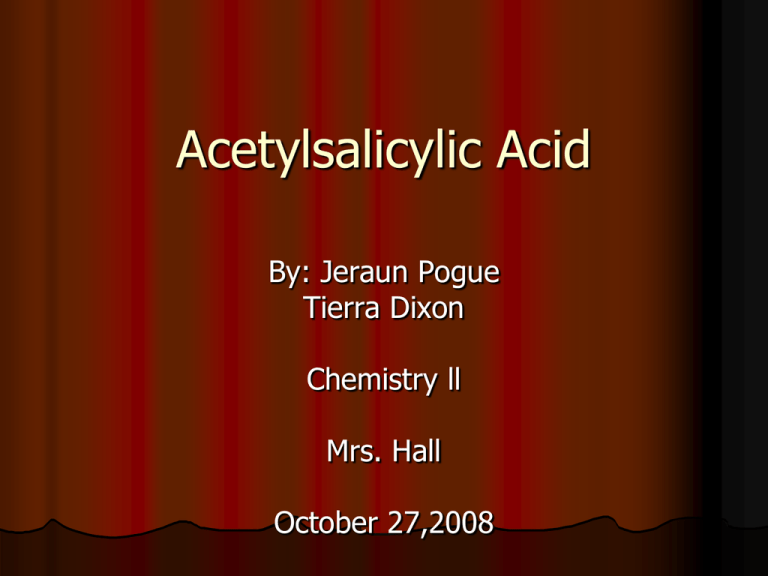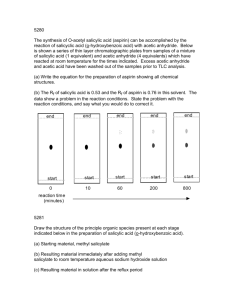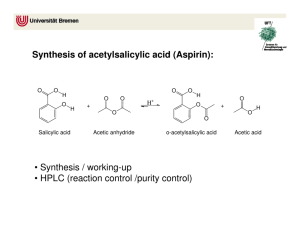
Acetylsalicylic Acid
By: Jeraun Pogue
Tierra Dixon
Chemistry ll
Mrs. Hall
October 27,2008
Abstract
The study’s main objective was to find the purity aspirin throughout six
different experiments. In Standardization of a Pipette, the determine to
calculate values that are not measurable with the equipment provided. The
average amount of drops per one mL was 18.33;there is 0.33 mL for every
one drop. Synthesis of Aspirin lab showed how to make aspirin. The lab
Determination of Melting Point was used to get the melting point of each lab
because melting point shows aspirin purity. Several sample compounds were
placed into a Mel-Temp apparatus and melted a high temperatures. Relative
Purity was also used to check chemical compounds color before and after
they mixed with iron(III)chloride. Introduction to Digital Spectrophotometer lab
familiarized groups with the functions of the Spectrophotometer 20-D
machine. Spectrophotometric Analysis of Aspirin lab purpose was to
determine the amount of aspirin in a commercial aspirin product. This lab
may also be used to determine the purity of the aspirin produced in the
Microscale Synthesis of Acetylsalicylic Acid lab. The overall conclusion to the
study found was the Chemistry II sample aspirin was not pure. The chemicals
used to make the samples were not pure either. the Chemistry IA and
Chemistry IB sample aspirin was not pure either. The chemicals used in the
making the aspirin were originally pure but mixed together they came out in
History of Aspirin
Aspirin
is used as a pain reliever and fever
depressant. It was originally made from
willow bark extract but today is made from
salicylic acid (sodium calculate).
Hippocrates was the first scientist to
prescribe bark tree leaves as a pain
reliever. A German scientist named Felix
Hoffman that lived in Bayer Germany was
the first person to stabilize acetylsalicylic
acid when he used it to relieve his father’s
rheumatism in 1897.
History of Aspirin
In
1828 the active ingredient in willow bark was isolated
by Johann Buchner into a bitter tasting yellow needlecrystal form called salicin. Around 1920, aspirin was
used to treat symptoms of pain related to rheumatism,
lumbago, and neuralgia. As years past aspirin history
expanded. In 1988, aspirin became used as a potential
lifesaver; it was approved by the FDA to prevent ministrokes in men and made standard therapy for previous
strokes in men.
Standardization of a
Pipette
The purpose of this experiment is to
determine to calculate values that are not
measurable with the equipment provided.
Data
Number of Drops per 1mL
Trial 1
20 drops
Trial 2
16 drops
Trial 3
19 drops
Formula for Average # of drops per 1mL = T1 + T2 + T3
/3
Average: __________18.33_____________
Formula for # of mL per drop: 1 drop x
1mL
1
# of drops
1 drop: __________0.33________mL
Results
The results in this experiment were not precise due
to a non-repeating pattern, such as, plus or minus
one. The numbers came out to plus three then plus
one. The accepted value for this experiment is 20.
the results: 20, 16,19 came out to be 91.65%
accurate with a random error of 8.35% because the
results were above and below the accepted value.
To improve the lab there should be a more accurate
and precise counting of the droplets, and there
should most likely be more test to make sure the
results are as precise as possible.
Synthesis of Aspirin
The purpose of this experiment is to
make aspirin that is equivalent to half
of an aspirin tablet.
Data
Mass of salicylic acid used
0.914
g
Mass of filter paper and product
0.139
g
Mass of filter paper
1.76 g
Mass of product after drying
0.846
g
Results
In synthesis of aspirin the conclusion formed was
that the product had 21.16% error being 78.84%
accurate. The measurements compared to the
standard were precise but the results were not. The
lab also had a theoretical yield of 37.3%. Reasons
the results were not precise could be that some of
the chemicals were still in the sample or when the
sample was vacuum packed some of the sample
could have been absorbed. Also the sample could
not have been fully made.
Melting Point
The purpose of this experiment is to
determine the melting point of
observed compounds because it shows
the purity of a compound.
Data for Melting Point
Sample
Compounds
Trail 1
Observed
Melting
Point/
Range
Trail 2
Observed
Melting Point/
Range
Trail 3
Observed
Melting
Point/ Range
Average
(of all 3
Trails)
Observed
Melting
Point/ Range
Possible
Contaminant
Acetylsalicylic
Acid
140°C
140°C
140°C
140°C
4% increase
Unknown
containment
Salicylic Acid
168°C
168°C
168°C
168°C
9% increase
with an
unknown
contaminant
Phosphoric Acid
42.35°C
42.35°C
42.35°C
42.35°C
Standard
Data for Melting Point
cont.
Acetic
Anhydride
-73°C
-73°C
-73°C
-73°C
Standard
Water
0°C
0°C
0°C
0°C
Standard
Chemistry II
Sample
16.6°C
16.6°C
16.6°C
16.6°C
Standard
Chemistry I A
Sample
124°C
124°C
124°C
124°C
Contaminated with
acetylsalicylic acid,
salicylic acid,
phosphoric acid, and
acetic anhydride
Chemistry I B
Sample
150°C
150°C
150°C
150°C
Contaminated with
acetylsalicylic acid,
salicylic acid,
phosphoric acid, and
acetic anhydride
Data for Melting Point cont.
Enteric Aspirin
169°C
169°C
169°C
169°C
Contaminated with
acetylsalicylic acid,
salicylic acid,
phosphoric acid,
and acetic
anhydride
Acetic Acid
16.6°C
16.6°C
16.6°C
16.6°C
Contaminated with
acetylsalicylic acid,
salicylic acid,
phosphoric acid,
and acetic
anhydride
Assured
Aspirin
150°C
150°C
150°C
150°C
Contaminated with
acetylsalicylic acid,
salicylic acid,
phosphoric acid,
and acetic
anhydride
Results
The conclusion for melting points was that
acetylsalicylic acid had a temperature of 140*C this
4% increase had an unknown cause. Salicylic acid
had temperature of 168*C this 9% had an
unknown contaminant. Phosphoric acid was a
standard because of its temperature 42.35*C.
Acetic anhydride was a standard with a -73*C
temperature. Water was a standard with a 0*C
temperature. Chemistry II sample aspirin was a
standard with a temperature f 16.6*C. Chemistry IA
sample was Contaminated with acetylsalicylic acid,
salicylic acid, phosphoric acid, and acetic anhydride.
Relative Purity
The purpose of the this experiment is
to check the purity of certain such
as: salicylic acid, assured aspirin,
enteric aspirin, Chemistry IA sample
aspirin, Chemistry IB sample aspirin,
Chemistry II sample aspirin,
acetylsalicylic acid, acetic anhydride,
acetic acid, phosphoric acid.
Data
Chemical
compound
Salicylic acid
Color before
FeCl3
White
Color after
FeCl3
Purple
Assured aspirin White
Clear
Enteric aspirin
White
Light pink
Chemistry IA
sample aspirin
Chemistry IB
sample aspirin
White
Yellow
White
Purple
Data cont.
Chemistry II
sample aspirin
Acetylsalicylic
acid
Acetic
anhydride
Acetic acid
White
Yellow
White
Yellow
Clear
Gold
Clear
Orange
Phosphoric acid Clear
Clear
Results
The conclusion based on the results of the mixture of each of the ten
chemicals with Iron (III) chloride (FeCl3) was determined by each
chemicals color after the mixture. If any of the chemicals are
composed of six molecules of phenol combined with one Iron (III)
ion should produce a positive (purple) test with Iron (III) chloride.
Salicylic acid and chemistry IB sample aspirin were originally white,
and then mixed with FeCl3 they turned purple meaning they
produced a positive test. Salicylic acid would be a standard because
it was tested at its pure state and the chemistry IB sample aspirin
contains a high amount of salicylic acid. Chemistry IA sample aspirin,
chemistry II sample aspirin, and acetylsalicylic acid were white and
had yellow results meaning they were not positive. Acetylsalicylic
acid would be used be used as a standard and it would be known
that that it can be found in the chemistry IA sample aspirin and
chemistry II sample aspirin. Acetic Anhydride was clear ending in a
golden color being negative and a standard. Phosphoric acid was
clear with clear results and it is also a standard meaning assured
aspirin contains a large amount of phosphoric acid because of its
clear results. All the chemicals that turned out to be a standard were
that way because when they were at their purest form. Mistakes
made would be adding to much FeCl3. Improvements to this lab
would be to be more precise with the amount the amount of
chemicals used and recorded.
Intro to Specs 20-D
The purpose of the this experiment is
to familiarize you with the basic
technology and workings of the Spec20D- how to prepare a sample, which
knob or button does what, and how to
read and understand the display.
Data
Color
Red Orange Yellow Green Blue
Violet
Wavelength
630 590
400
569
500
460
Results
With all the facts gathered from the
experiment the conclusion made was that
the spec-20 D is used to calculate
absorbance, transmittance, and
concentration of a certain wavelength. In
the experiment it was able to be determined
that certain colors were produced with
certain wavelength. It was able to be known
the function of each part of the machine.
The lab could’ve went wrong if the controls
were not working or if the students didn’t
pay attention. Improvements to lab are
unknown.
Specs
To determine the amount of aspirin in
a commercial aspirin product. This lab
may also be used to determine the
purity of the aspirin produced in the
Microscale Synthesis of Acetylsalicylic
Acid lab.
Data Chart for Absorbance
Average
Sample
salicylic acid
assured aspirin
2.5
2.0
0.3510
0.3163
1.5
1.0
0.2800
0.5
0.1797
0.1113
0.047
0.038333
0.04
0.024667
0.009667
0.107333
0.201333
0.087333
0.074333
0.116
0.04
0.012667
0.029
-0.009333
-0.018
-0.020333
-0.096667
0.096
-0.008
-0.022333
0.001
-0.017333
-0.021333
-0.030333
-0.036333
0.078
0.068333
0.062333
0.082667
0.025667
0.095333
0.087667
-30.68033
-0.028
-0.071667
0.014667
-0.019333
0.005333
0.003
0.006
0.461333
0.273333
0.182333
0.133333
0.108333
enteric aspirin
Chemistry IA
Chemistry IB
Chemistry II
acetylsalicylic acid
acetic anhydride
acetic acid
phosphoric acid
Data Chart for
Transmittance Average
Sample
2.5
2.0
1.5
1.0
0.5
salicylic acid
44.6667
48.2667
52.8667
66.2000
77.4000
assured
aspirin
84.13333
86.93333
86.93333
91.8
91.8
enteric aspirin 77.93333
63.86667
55.7
84.26667
77.73333
Chemistry IA
91
97.33333
93.6
102.1333
104.4667
Chemistry IB
111.1333
110.5333
80.4
101.6667
105.5
Chemistry II
100
105.1333
105.1333
107.2
108.6667
acetylsalicylic
acid
83.6
85.4
86.6
94.93333
94.2
acetic
anhydride
76.33333
81.2
104.9333
105.9333
116.1333
acetic acid
64.34033
71.13233
66.939
65.06333
66.33767
phosphoric
Salicylic Acid
Absorbance and Concentration for Salicylic Acid
Transmittance and Concentraion for Salicylic Acid
0.4000
90.0000
0.3510
0.3500
80.0000
77.4000
0.3163
70.0000
0.3000
66.2000
0.2800
60.0000
0.2000
Series1
0.1797
Transmittace
Absorbance
0.2500
52.8667
50.0000
48.2667
Series1
44.6667
40.0000
0.1500
30.0000
0.1113
0.1000
20.0000
0.0500
10.0000
0.0000
0.0000
1
2
3
Concentration
4
5
1
2
3
Concentration
4
5
Assured Aspirin
Transmittance and Concentration for Assured
Absorbance and Concentration for Assured
100
0.05
0.047
0.045
96.93333333
0.04
95
0.04
0.038333333
0.035
91.8
Absorbance
0.025
Series1
0.024666667
0.02
Transmittance
90
0.03
86.93333333
Serie
86.93333333
85
84.13333333
0.015
0.01
0.009666667
80
0.005
75
0
1
2
3
Concentration
4
5
1
2
3
Concentration
4
5
Enteric Aspirin
Transmittance and Concentration for Enteric
Absorbance and Concentration for Enteric
90
0.25
84.26666667
80
77.73333333
70
0.201333333
0.2
77.93333333
63.86666667
60
Absorbance
Series1
0.116
0.107333333
Transmittance
55.7
0.15
50
Series1
40
0.1
0.087333333
30
0.074333333
20
0.05
10
0
0
1
2
3
Concentration
4
5
1
2
3
Concentration
4
5
Chemistry I A
Absorbance and Concentration for Chemistry 1 A
Transmittance and Concentration for Chemistry 1 A
0.16
120
0.15
0.14
100
96.8
0.125333333
91.46666667
0.12
87.8
87.2
80
0.104
78.73333333
0.08
Series1
0.06
Transmittance
Absorbance
0.1
60
Series1
0.059666667
0.055
40
0.04
20
0.02
0
0
1
2
3
Concentration
4
5
1
2
3
Concentration
4
5
Chemistry I B
Chemistry II
Acetylsalylic Acid
Transmittance and Concentration for Acetylsalicylic Acid
Absorbance and Concentration for Acetylsalicylic Acid
96
0.09
94.93333333
0.082666667
0.08
0.078
92
0.07
0.068333333
0.062333333
90
0.06
88
0.05
Series1
0.04
Transmittance
Absorbance
94.2
94
86.6
86
Series1
85.4
84
83.6
0.03
0.025666667
82
0.02
80
0.01
78
0
1
2
3
Concentration
4
5
76
1
2
3
Concentration
4
5
Acetic Anhydride
Acetic Acid
Phosphoric Acid
Absorbance and Concentration for Phosperic Acid
Transmittance and Concentration for Phosphoric Acid
0.5
90
0.461333333
0.45
80
77.86666667
73.53333333
0.4
70
65.73333333
0.35
60
0.273333333
0.25
Series1
0.2
Transmittance
Absorbance
0.3
53.86666667
50
Series1
40
34.4
0.182333333
30
0.15
0.133333333
0.108333333
0.1
20
10
0.05
0
0
1
2
3
Concentration
4
5
1
2
3
Concentration
4
5
Absorbance Chart
Absorbance Values
0.8
0.7
0.6
0.5
standard
SA
Assured
Absorbance
0.4
Enteric
Acetylsalicylic Acid
0.3
Phosphoric Acid
Chem. IA
0.2
Chem. IB
Acetic Acid
Chem.2
0.1
0
Concentration
-0.1
-0.2
Conce ntration
Transmittance Values
Transmittance Values
140
120
Standard
100
SA
Transmittance
Assured
Enteric
80
Acetylsalicylic Acid
Phosphpric
Chem. I A
60
Acetic Acid
Acetic Anhydride
Chem II
40
Chem I B
20
0
Concentration
Conce ntration
Results
In conclusion, none of the samples reached the absorbance
standard. They all crossed each other but none reached the
standard point. In transmittance, salicylic acid, acetic acid,
phosphoric acid, and enteric acid all crossed the standard during
the 0.5 line. The samples were not pure.
Conclusion
•
•
The overall conclusion to the study found was the Chemistry II sample
aspirin was not pure. The chemicals used to make the samples were not
pure either. The Chemistry IA and Chemistry IB sample aspirin was not
pure either. The chemicals used in the making the aspirin were originally
pure but mixed together they came out in an impure form. The
standardization of a pipette was a cause for an impure result. If the
students were more precise with the count then when used in the making
of acetylsalicylic acid the impurity would not have been thrown off.
Relative purity showed the impure state. Reasons the relative purity
possibly showed an impure result would be because the students put too
much sample in the capillary tube to be tested so since the students were
going off results written down instead of the first results from when the
samples were made it would most likely have been pure. Melting points
showed the chemicals used in the making of the aspirin were impure.
Since the melting points of the chemicals of the chemical samples were
not closely related to the standard they were impure because of
contamination. The spec lab was the most obvious when it came to
showing the impurity of the sample. The results showed in charts 2and 3
were nowhere near the standard.
References
http://www2.volstate.edu/CHEM/1110/Labs/
Spectrophotomery.htm
http://inventors.about.com/library/blaspirin.h
tm
http://www.ic.sunysb.edu/class/chel34/lectu
res/134pll.pdf
©2000, 2003 by Science in Motion. All
rights reserved
Darryl Rodgers and Carlos McCants






